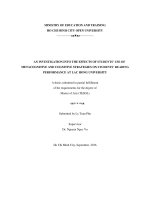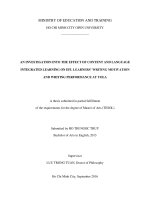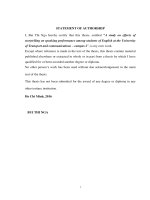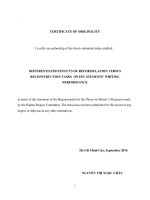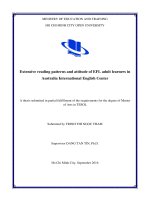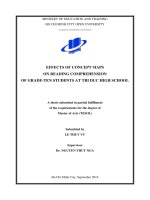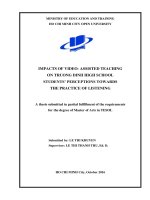The impact of video based listening activities on students listening comprehension at tan binh continuing education center a thesis submitted in partial fulfillment of the requirements for the degree of master of arts
Bạn đang xem bản rút gọn của tài liệu. Xem và tải ngay bản đầy đủ của tài liệu tại đây (2.94 MB, 127 trang )
STATEMENT OF AUTHORSHIP
I certify that this thesis entitled “The impacts of video-based listening activities on
students’ listening comprehension at Tan Binh Continuing Education Center” is my
own work.
Except where reference is made in the text of the thesis, this thesis contains no
material published elsewhere or extracted in whole or in part from a thesis by which I have
qualified for or been awarded another degree or diploma.
No other person’s work has been used without due acknowledgement in the main text
of the thesis.
This thesis has not been submitted for the award of any degree or diploma in any
other tertiary institutions.
Ho Chi Minh City, 2016
Le Thi Ngoc Thuy
i
ACKNOWLEDGEMENTS
To do the thesis successfully, I have to rely on the following people’s help,
cooperation, collaboration, instructions, and comments.
Firstly, I am very grateful to the teaching staff and students in Tan Binh Continuing
Education Center. I would like to thank Mr. Tien, the principal, for allowing me to teach the
listening course using designed videos and his encouragement. I thank Ms. Nhai, the viceprincipal, for her encouragement. I am very grateful to Mr. Dien for arranging the audiovisual
room for me and Ms. Ha for her supporting to arrange and checking my papers. I would like
to thank Ms. Kim Nen, Ms. Huyen, Ms. Hien, and Mr. Hoang - my colleagues, for their
supporting during the listening course. My study would not completely have been successful
if there had not been the participation from the students in Class 11C2 and Class 11C5 whom
I thank very much. I also thank the teachers who were mainly responsible for managing these
classes for encouraging the students to participate actively and sincerely in the training.
Secondly, I thank my fellow classmates in TESOL 7 for their contributions of
suggestions, thoughts, and views.
Most specially, I would like to express my gratitude to Dr. Nguyen Thuy Nga for her
careful supervision, deep commitment, and detailed instructions. Besides, I am grateful to the
professors and other doctorates for their comments and evaluations.
ii
ABSTRACT
Using video-based activities to train English foreign language students has been
widely applicable around the world (Williams & Lutes, 2012); however, no study has been
conducted in Tan Binh Continuing Education Center. Hence, the purpose of the current study
was to investigate whether the video-based activities were effective in enhancing students’
listening comprehension and their attitudes towards this teaching technique. The study
involved totally 86 eleventh-graders whose English proficiency was elementary and they are
now being taught listening by relatively conventional method at TB CEC such as listening to
the tape only one time and then memorizing transcripts to be able to do listening exercises
which will definitely appear on A Certificate Examination. Class 11C2 was selected as the
control group, and the experimental group came from Class 11C5. The control group was
taught listening by the existing method in the school, and the experimental group was exposed
to video-based activities. The pretest, posttest, and questionnaire were employed to collect
data.
The results of the study highlighted the positive effects of video-based activities in
improving students’ listening comprehension as well as positive attitudes from the
participants of the experimental group. These lead to conclusions that adopting video-based
listening activities indeed helped the students enhance their listening skills, activate students’
prior knowledge, and motivate students a lot in learning listening. The study also mentioned
several difficulties in applying video-based activities, creating videos as well as
recommendations for better video treatment. Finally, it addressed some implications and
called for further research to investigate video-based activities in a wider context.
Key words: impacts, videos-based listening activities, listening comprehension
iii
TABLE OF CONTENTS
STATEMENT OF AUTHORSHIP ............................................................................................................................i
ACKNOWLEDGEMENTS .....................................................................................................................................ii
ABSTRACT ........................................................................................................................................................ iii
TABLE OF CONTENTS ........................................................................................................................................ iv
LIST OF FIGURES ............................................................................................................................................. viii
LIST OF TABLES ................................................................................................................................................ ix
ABBREVIATIONS AND SYMBOLS ....................................................................................................................... x
CHAPTER 1 ........................................................................................................................................................1
INTRODUCTION ................................................................................................................................................1
1.1. Background of the study .............................................................................................................................. 1
1.2. Problem of the study .................................................................................................................................... 2
1.3. Statement of the purpose ............................................................................................................................ 4
1.4. Research questions ...................................................................................................................................... 4
1.5. Significance of the study .............................................................................................................................. 5
1.6. Scope of the study ........................................................................................................................................ 5
1.7. Overview of the thesis chapters ................................................................................................................... 6
CHAPTER 2 ........................................................................................................................................................7
LITERATURE REVIEW .........................................................................................................................................7
2.1. Listening comprehension ............................................................................................................................. 7
2.1.1. Problems of learners’ in listening comprehension .............................................................................. 7
2.1.2. Solutions to the listening problems ..................................................................................................... 8
2.1.3. Methods of training ........................................................................................................................... 11
2.1.3.1. Aprroach of listening .................................................................................................................. 11
2.1.3.2. Listening strategy ....................................................................................................................... 12
2.1.4. Measurement. ................................................................................................................................... 13
2.2. Task-Based Language Teaching ................................................................................................................. 13
2.2.1. Definition of task-based language teaching ....................................................................................... 13
2.2.2. Task types .......................................................................................................................................... 14
2.2.3. Features of Task-based language teaching method. ......................................................................... 15
2.2.4. Task process ....................................................................................................................................... 16
2.2.5. Criteria for listening tasks .................................................................................................................. 17
2.3. Videos in language classroom ................................................................................................................... 18
2.3.1. Concepts of videos ............................................................................................................................. 18
2.3.2. Classification of videos ....................................................................................................................... 19
iv
2.3.2.1. Authentic videos ........................................................................................................................ 19
2.3.2.2. Educational Videos ..................................................................................................................... 20
2.3.3. Benefits and drawbacks of using videos in language classroom ....................................................... 21
2.3.3.1. Benefits of using video in language classroom .......................................................................... 21
2.3.3.2. Drawbacks of using videos in language classroom .................................................................... 26
2.3.3.3. Video Evaluation and Selection....................................................................................................... 27
2.3.4. Techniques and activities of using videos in language classroom ..................................................... 29
2.3.4.1. Techniques of using videos in language classroom .................................................................... 29
2.3.4.2. Video-based activities in language classroom ............................................................................ 30
2.3.5. Implementing videos in teaching listening ....................................................................................... 32
2.4. Schema theory ........................................................................................................................................... 33
2.4.1. Definition of schema .......................................................................................................................... 33
2.4.2. Classification of schema ..................................................................................................................... 33
2.4.3. Impacts of schemata on language learning ....................................................................................... 34
2.4.4. Correlation between video-based listening activities, schemata, and listening skill ......................... 34
2.5. Previous studies ......................................................................................................................................... 35
2.6. Summary of the chapter ............................................................................................................................ 36
CHAPTER 3 ......................................................................................................................................................37
METHODOLOGY ..............................................................................................................................................37
3.1. Research approach .................................................................................................................................... 37
3.2. Research setting......................................................................................................................................... 39
3.3. Participants of the study ............................................................................................................................ 40
3.4. Training procedures ................................................................................................................................... 40
3.4.1. Control group (Class 11C2) ................................................................................................................ 41
3.4.1.1. Instructional materials ............................................................................................................... 41
3.4.1.2. Teaching plan for listening periods of CG .................................................................................. 42
3.4.1.3. Lesson plans for CG .................................................................................................................... 43
3.4.2. Teaching listening in experimental group (Class 11C5) ..................................................................... 44
3.4.2.1 Video-based listening course ...................................................................................................... 46
3.4.2.2. Implementation of designed videos ........................................................................................... 48
3.5. Measures of the study ............................................................................................................................... 50
3.5.1. Tests of both CG and EG .................................................................................................................... 50
3.5.1.1. Design of the tests ...................................................................................................................... 50
3.5.1.2. Administering the listening pretest and posttest....................................................................... 52
3.5.1.3. Scoring ........................................................................................................................................ 52
3.5.2. Questionnaire instrument.................................................................................................................. 52
3.5.2.1. Designing the questionnaire ........................................................................................................... 53
3.5.2.1.1. Content of the questionnaire ............................................................................................. 53
3.5.2.1.2. Administering the questionnaire ........................................................................................ 54
3.6. Data collection ........................................................................................................................................... 55
3.7. Analytical framework ................................................................................................................................. 55
3.7.1. The statistical tests ............................................................................................................................ 56
3.7.2. Descriptive data analysis .................................................................................................................... 56
v
3.7.3. Qualitative data analysis .................................................................................................................... 56
3.8. Summary of the chapter ............................................................................................................................ 57
CHAPTER 4 ......................................................................................................................................................58
DATA ANALYSIS, FINDINGS AND DISCUSSION .................................................................................................58
4.1. Performance of both CG and EG on pretest and posttest .......................................................................... 58
4.1.1. EG’s and CG’s performance on the pretest ........................................................................................ 58
4.1.2. Control group’s performance on the pretest and posttest ............................................................... 59
4.1.3. Experimental group’s performance on the pretest and posttest ...................................................... 60
4.1.4. Experimental group’s and control group’s performance on the posttest ......................................... 62
4.2. Students’ attitudes towards video-based activities in class ....................................................................... 63
4.2.1. Theme 1: video-based treatment’s benefits ...................................................................................... 64
4.2.2. Theme 2: Course design ..................................................................................................................... 65
4.2.3. Theme 3: Instruction effects .............................................................................................................. 67
4.3. Evaluation of overall course....................................................................................................................... 68
4. 4. Discussion of findings ................................................................................................................................ 69
4.4.1. Summary of the main findings ........................................................................................................... 69
4.4.2. Effect of using video-based activities by the CLT Approach on the students’ listening skill .............. 70
4.4.3. Students’ attitudes towards video-based listening treatment. ......................................................... 70
4.4.4. Students’ satisfaction with the overall course ................................................................................... 71
4.5. Summary of the chapter ............................................................................................................................ 72
CHAPTER 5 ......................................................................................................................................................73
CONCLUSION AND RECOMMENDATIONS .......................................................................................................73
5.1. Overview of the study ................................................................................................................................ 73
5.2. Implications and recommendations........................................................................................................... 74
5.3. Limitations of the study ............................................................................................................................. 76
5.4. Suggestions for further research................................................................................................................ 77
5.5. Conclusion .................................................................................................................................................. 77
REFERENCES ....................................................................................................................................................78
APPENDICES....................................................................................................................................................84
APPENDIX A: PRE-TEST ..................................................................................................................................... 84
APPENDIX B: TAPESCRIPTS OF PRE-TEST .......................................................................................................... 85
APPENDIX C: POST-TEST ................................................................................................................................... 86
APPENDIX D: TAPESCRIPTS OF POST-TEST ........................................................................................................ 87
APPENDIX E: LISTENING SCORES OF PRE- AND POST-TEST OF BOTH GROUPS ................................................. 88
The listening scores of CG (Class 11C2) and EG (Class 11C5) on the pretest and posttest ................................88
APPENDIX F: QUESTIONNAIRE .......................................................................................................................... 91
vi
Part 1: Video-based treatment’s benefits ..................................................................................................... 91
Part 2: Course Design .................................................................................................................................. 92
Part 3: Instruction Effects ............................................................................................................................ 93
Part 4: Overall Course .................................................................................................................................. 94
APPENDIX G: DATA ANALYSIS OF POST QUESTIONNAIRE ................................................................................. 99
APPENDIX H: LESSON PLAN FOR THE EXPERIMENTAL GROUP ....................................................................... 102
APPENDIX I: LESSON PLAN FOR THE CONTROL GROUP .................................................................................. 107
APPENDIX K: UNIT 52: THE EIGHT O’CLOCK NEWS ......................................................................................... 111
nd
APPENDIX L: CONTENT OF LISTENING PERIODS IN 2 SEMESTER .................................................................. 112
APPENDIX M: DESIGN OF THE VIDEO-BASED LISTENING COURSE .................................................................. 113
vii
LIST OF FIGURES
Figure 1. Students’ rating of the overall course…………………………………..70
viii
LIST OF TABLES
Table 2.1. Task-based lesson plan model ................................................................................ 17
Table 2.2. Task-Feedback Cycle .............................................................................................. 18
Table 2.3. Guidelines for Interactivity that Promote Learning from Video-based Models
Classified by Type..................................................................................................................... 31
Table 3.1. Pre-test and Post-test Design .................................................................................. 38
Table 3.2. Teaching plan for listening periods of CG ............................................................. 43
Table 3.3. A model of a lesson plan for CG ............................................................................. 45
Table 3.4. Differences between listening course of CG and EG .............................................. 47
Table 3.5. Design of the video-based listening course for EG ................................................. 48
Table 3.6. A sample of lesson plan for video-based listening activities according to ............. 49
Table 3.7. The design of the questionnaire............................................................................... 54
Table 4.1. Mean scores of listening pretests for EG and CG ................................................... 59
Table 4.2. T-test value of listening pretest for experimental and control groups .................... 59
Table 4.3. Mean scores of listening pre-post-tests for control group ...................................... 60
Table 4.4. Correlation and t-test value of listening pre-post-tests for control group………...61
Table 4.5. Mean scores of listening pre-post-tests for EG……………………………………….62
Table 4.6. Correlation and t-test value of listening pre-post-tests for EG…………..………...62
Table 4.7. Mean scores of listening posttests for EG and CG…………………………………...63
Table 4.8. T-test value of listening posttests for experimental and control groups ................. 63
Table 4.9. Students’ attitudes towards video-based treatment’s benefits ................................ 65
Table 4.10. Students’ attitudes towards course design ............................................................ 67
Table 4.11. Students’ attitudes towards the instruction effects ................................................ 68
ix
ABBREVIATIONS AND SYMBOLS
TBLT
Task-based Language Teaching
CLT
Communicative Language Teaching
TB CEC
Tan Binh Continuing Education Center
EV
Educational Video
CG
Control group
EG
Experimental group
EFL
English as a Foreign Language
ex
for example
HCMC
Ho Chi Minh City
L1
First language
L2
Foreign language
N
Total number
No.
Number
p
Probability
p.
Page
pp.
Pages
Q(s)
Question(s)
r
Correlation
S(s)
Student(s)
SD
Standard deviation
SE
Standard error
SEM
Standard error of the mean
x
xi
CHAPTER 1
INTRODUCTION
This chapter will provide the background for the present study which is followed by
the introduction of the problem of the study. Besides, the purpose of the study will be stated
and the research questions will be proposed. Subsequently, the significance of the study will
also be mentioned and the scope which the study has will be referred to. Finally, the
overview of the chapters in the study will be glanced at.
1.1. Background of the study
Since 1960, a variety of English language teaching methodology and approaches have
developed (Richards & Rodgers, 2001). Each method or approach has had a great
contribution to the development of English language teaching and learning.
Maley (2009, 2010) considered moving images in the form of videos as an important
part of the input that plenty of videos are available in the Internet made access relatively easy,
and accessing to such resources could also be obtained outside the classroom. King (2002)
found that using videos had 12 positive results towards language teaching and learning.
Similarly, Berk (2009) who placed the great importance of videos in English language
teaching and learning determined 20 positive outcomes of using videos. In general, the
outcomes that Berk (2009) and King (2002) mentioned above consist of motivating students,
improving language areas and language skills.
Referring to the listening skill in particular, Stempleski and Tomalin (2001) assumed
that the teachers helped their students to improve their listening by encouraging them to
observe what went on and heard what was said while they watched the videos. The
importance of videos in English language teaching and learning was acknowledged in the
solution to the problems of spoken language (Sherman, 2003). To encourage the use of
videos in English language teaching and learning, Meskill (2006) described the
characteristics of videos made themselves a valuable input for teaching and learning
listening. Similarly, letting students watch videos, see and hear language in use to practice
their listening skill was the main procedure in the video-based lesson sequences that Harmer
(2007) designed. In short, videos have been useful tools for teaching and learning listening.
According to Berk (2009), the use of videos in teaching listening has become popular in the
world and it has resulted in the enormous success in the listening courses.
1
According to discussion among teachers in 2015 working at TB CEC, students of the
school have a little motivation towards learning English as well as learning listening while
the book set which is Streamline English consisting of the textbook, the workbook and two
CDs; no videos have employed in English language teaching and learning at Tan Binh CEC.
Therefore, the author decided to use video-based activities with a belief that videos can help
students in listening comprehension and keep them interested in with lively images.
1.2. Problem of the study
In general, the Vietnamese high school students’ level of listening is low (Le Van
Canh, 2008) , and is extremely low with students at CEC where English is an optional subject
- the results of this subject does not affect to the assessment process of students, so they are
not eager for practicing listening. These issues were mentioned in several articles, such as
“Alert on the quality of English in upper secondary education” in Dan Tri News on April 5th,
2008; or in Thanh Nien News on September 29th, 2010, Ngoc Han, Tuyet Van and Dang
Nguyen stated that Vietnamese students could not listen simply after studying English for
seven years in general education; or in the survey of English level in three high schools, Le
Van Canh (2008) reported that 90 percent of the students could not listen at all.
In Vietnam, videos have been used as an effective tool to teach English, especially
listening, for instance, on Vietnam Television 2 through the program “Thirty Minutes of
English a Day” with the instructions of the teacher Nguyen Quoc Hung, the learners have
learnt English through videos (Nguyen Quoc Hung, 2009), or some Vietnamese teaching tool
websites, which have used videos arranged according to the English level and the topic, are
“hellochao.vn/video-hoc-tieng-anh/, tienganh123.com/menu/hoc-qua-clip, and aroma.vn/hoctieng-anh-qua-video/”.
Although video clips have been employed in English language teaching and learning
in Vietnam as the application of information technology in education and training in schools
started to be mobilized (Vietnam Ministry of Education and Training, 2008), the use of
videos for language teaching in the high school is limited as they are mainly used in the
teaching demonstrations (Vietnam Ministry of Science and Technology, 2012). In fact,
English teacher principally employed in electronic lessons with the use of the Microsoft
PowerPoint presentation (Vietnam Ministry of Education and Training, 2008).
Vietnam Ministry of Education and Training (2008) reported that Vietnamese
graduated-high school students have low level of English proficiency; so do students in TB
2
CEC, they could not speak and listen after the period of learning English for seven years.
Some of reasons of the students’ low level of proficiency are the students’ lack of motivation,
the grammar-focused examinations, and the de-contextualization of textbooks (Nguyen
Thanh Tung, 2010). Videos-based activities are believed to raise students’ interest in their
learning English and in their listening practice.
In a private conversation in 2015 with three teachers working at TB CEC the author
learnt that students in this school have a little motivation towards learning English especially
learning listening. This is because of the fact that English is an optional subject, and the result
of this subject does not affect to the assessment process of students in the semester. Only
some students who recognize the need of learning English pay attention to the English
lessons. In addition, a large amount of students here failed the entrance examination to the
state high schools, therefore, their studying abilities are not good, and a little motivation in
learning has been made. One teacher in the conversation in 2015 said that the material and
listening traditional training also demotivate students. The center used Streamline English
which was published in 1991 as the main teaching textbook, so the information given in that
textbook was out of date. Therefore, students are not interested in learning listening with such
material. Those teachers said that they are using traditional techniques to teach listening. No
supplementary material was added, no electric lessons were employed, and no
communication happened in classes. According of the mentioned teacher, students are not
familiar with the vocabulary and listening topics presented in the textbook. That surely has
big effect on students’ listening comprehension: they cannot improve their listening
comprehension if they do not know anything about them. Besides, something they have
already known, but they cannot activate their prior knowledge in order to listen
comprehensively. Those are the reasons why, students at TB CEC are afraid of as well as
uninterested in listening learning. Video-based activities were used in the author’s class with
the belief that they would provide input; activate their prior knowledge, as well as raise
students’ interest in learning listening with colorful, truthful image and sound.
What cannot be denied is that the supplement and possession of related background
knowledge or in other words the construction and activation of schemata can actively
facilitate listening comprehension. Whereas, videos play a vital role in accumulating
students’ prior experience and knowledge and even very few research have been mentioned
or investigated to investigate the correlation between video-based activities and listening
comprehension basing on schema theory. The previous research mostly spent concern on
3
listening anxiety, little for listeners’ prior knowledge. The author believes that the
interpretation of new coming information basing on the previous experience and prior
knowledge will affect much on listening comprehension. If students have no background
knowledge in a certain topic, they cannot interpret new input successfully or they can pay
less attention to listening tasks. Therefore, the author believed that video-based listening
activities will have positive impacts on students’ listening comprehension as they are
reasonable and logical employed officially in teaching listening at TB CEC. Besides, this
research was carried with the hope of filling in somehow the research gap in this field at
Vietnamese context as well as at TB CEC.
1.3. Statement of the purpose
Attempting to fill in the gaps in existing research and to advance research on videobased activities, the author investigates the impacts of video-based activities on students’
listening comprehension after a prolonged engagement in such video-based activities. The
study considered the correlation between video- based activities and listening skill. The study
also elicited the reflections on the experience of improving listening comprehension after this
prolonged engagement in the activities. It was also an aim of the research to find out how
students at TB CEC in Vietnam felt about such video-based activities.
In short, the present study planed:
•
To investigate the impacts of video-based activities on students’ listening
comprehension.
•
To explore the students’ attitudes towards the implementation of video-based
listening activities.
1.4. Research questions
In order to help the 11th graders in TB CEC to improve their listening skill, there was
a need to answer to the questions as a guideline for the study:
1.
To what extent do video-based activities have impacts on students’
listening comprehension after the training?
2.
What are student’s attitudes towards the implementation of video-based
activities?
4
Overall, the study consisted of two variables: (1) an independent variable, which was
the implementation of video-based listening activities with schema theory; and (2) a
dependent variable, which was the students’ listening scores.
1.5. Significance of the study
Theoretical and practical importance was two angles which were expected to show in
this study:
Theoretical importance:
It was important to get an insight into the principles of using video-based
listening activities with schema theory on the students’ listening skill.
It would introduce the impacts of using video-based listening activities on the
students’ listening skill.
The findings of this study would enrich the English language teaching and
learning literature in terms of using videos in order to activate students’ schema in teaching
listening.
Practical importance:
The recommendations of the study would help the students in TB CEC
improve their listening skill by using videos.
The study would stimulate the teachers to apply video-based activities in order
to explore its positive as well as limit negative impacts on the students’ listening skill.
The study would have the importance of engaging and motivating the students
in TB CEC through using videos in teaching listening.
The study would have the importance of improving the shortcomings of
Streamline English - Departures textbook with videos.
1.6. Scope of the study
The scope of the study is the conception which refers to the parameters under which
the present study will be operating. The problem in improving listening skill the author
eagers to find the solutions will fit within certain parameters. The parameters include the use
of videos in order to activate students’ prior knowledge, the 11 graders’ listening skill in TB
CEC and the impact of the method on their listening. Besides, the parameter also consists of
the students’ perceptions towards their listening skill developed after the treatment.
5
1.7. Overview of the thesis chapters
This thesis comprised the five chapters. The background, the rationale, the aim
together with the research questions of the present study, the theoretical and practical
significance of the thesis and the scope of the study were provided in the introductory
chapter. Next, chapter 2 presented the literature review relevant to the study of the effect of
using videos on learners’ listening skill. Chapter 3 was a detailed description of the
methodology including research setting, participants’ characteristics, sample size, measures,
research design, and analytical framework of this study. Analyzing and interpreting the data
collected from questionnaire, pretest, posttest and the discussion of the study results were the
focus of chapter 4. The conclusions, implications, recommendations, and suggestions for
further research were displayed in the last chapter.
6
CHAPTER 2
LITERATURE REVIEW
In Chapter 1, the author has problematized the issue of using videos with schemata
theory in English language teaching in TB CEC and made this research with the hope that
this issue can be solved. This was an experimental research which introduced the use of
videos-based listening activities with schemata theory in English language teaching in TB
CEC. This chapter shapes a theoretical framework which can serve as guidelines to lay the
foundation for the implementation of video-based activities into teaching listening
comprehension to students at CEC. It is comprised of the following issues: Videos in
language classroom; Video-based activities in which CLT and tasks based on videos are
presented; schema theory; conceptual framework of the study; and English language teaching
and learning at TB CEC context.
2.1. Listening comprehension
2.1.1. Problems of learners’ in listening comprehension
In an attempt to explore ways employed by students while doing listening tasks, the
research of Hien’s study (2008) mentioned three kinds of obstacles in which the first
stemmed from students, such as wrong prediction, unknown words and recognizing the main
points; and the second rooted from the listening materials such as unfamiliar topics, different
accents, authentic material (a very difficult one in non-native setting), speed of speech, or
long listening etc; and the last stemmed from physical settings like noise, poor tape recorder
quality, poor equipment.
In order to find out a good way to teach listening skill, Saricoban (1999) pointed that
lack of sociocultural, factual, as well as contextual knowledge of the target language can also
be an obstacle to listening comprehension. He stated that students get into trouble with
contradictions and omissions that are aspects of sandhi-variation which is known as the
changes occur in natural speech in consequence of environment, stress, intonation, rate of
speech ect (for example Jeet jet?- Did you eat yet?). Besides that, the ability to clarify and
point out the differences between written and spoken language is also a barrier that makes
listening task daunting since learners learn language in non-native setting. However, how can
learners acquire expletives, verbal taboos, culture-bound vocabulary etc still is a question.
Case (2008) stated eleven problems that make learners find listening difficult, they
are trying to understand every single word; they get left behind trying to work out what
7
previous words meant; they even don’t know the most important words or key words; they
don’t recognize the words that they already know; they have trouble with different accents;
they get tired-lacking listening stamina; they have a mental block; they are distracted by
background noise; they can’t cope with no images; or they have hearing problems; and the
last one is that they can’t distinguish the difference between different voices. Language
teachers should take the consideration of the eleven problems above to help their students
overcome in order to improve listening skill.
In addition, listening anxiety is also an obstacle of gaining good listening skill
(Golchi, 2012). Golchi’s study revealed that learners’ anxiety has bad effects on their
listening comprehension, the more their anxiety is, the worse their listening skill is; this leads
to the fact that students with a little anxiety performed their listening tasks better. The author
also pointed out that female learners and newer students were more anxious in listening than
male and longer time learners. Following the previous studies, Sharif’s and Ferdous’s (2012)
study pointed out the sources that evoke listening comprehension anxiety. They are anxiety
associated with attributes of instructors and learners in terms of lack of motivation, fear,
unfamiliarity, instructors’ personality; and anxiety with material and process such as nature
of speech, lack of input comprehensibility, level of difficulty, lack of repetition, lack of
processing time (require responding immediately to the listening comprehension), evaluation
on the target language; and the last one is that anxiety with other aspects in terms of poor
quality equipment, uncomfortable environment, lack of practice, and lack of visual support.
The problem is not all the language teachers recognize that their students are anxious during
listening. Definitely, they should find out the solution in order to reduce anxious time to
improve listening comprehension.
These mentioned listening problems need to be taken into account in language
classroom. The teachers should help students overcome these obstacles in order to better their
listening comprehension. The next section, the solutions to these listening problems were
presented with the hope of providing well-solved solutions.
2.1.2. Solutions to the listening problems
According to Saricoban (1999) there is an association between learners’ expectation,
their purposes, and listening comprehension. Therefore, a purpose of each listening task
should be given to our learners. Moreover, they need to be trained to understand what is
being said in listening text to get them to disregard redundancy, hesitation, or
ungrammaticality. They also need to be given a clear lead in what they are going to hear; and
8
to be given questions or tasks to clarify things in their mind is also vital. Besides that,
students need to know how to use the environment clues, how to induce main ideas from
speakers’ facial expression, posture, gesture, tone of voice and general surroundings
contribute information.
In order to deal with eleven problems which were mentioned above, Case (2008)
suggested useful solutions such as showing learners how to identify the important and key
words that they need to listen out for, giving them one very easy task to build up their
confidence, prep-teaching vocabulary, getting students involve by introducing topic,
discussing it first and then leading into the listening text, using the pause button or shorter
segments to give learners’ brains a chance to catch up and analyze main information,
teaching them to build up to much more difficult skill of guessing vocabulary and listening at
the same time, and the best way to build up their ability to deal with different accents in the
longer term is just to encourage them listening to a lot of English on T.V or on the radio with
BBC, etc, and solution for background noise is cutting down on noise which may cause
distraction. However, cutting down on noise which may make students distracted is not a best
way in long term. It would have been better if the author had suggested that teachers should
provide listening text with background noise which is conducted from little too much, and
then louder and louder time to time. That’s the way to train language learners to acquaint
with background noise to better their listening skill.
In the hope of finding out the optimal solutions of listening comprehension,
Rahmatian & Armiun (2011) stated that a video document is more effective in helping
learners anticipate what is going to be said or happen but it may cause disconcerted or
distracted, whereas, an audio one had the same advantages but could be misleading or
equivocal at times. Using videos in the listening classroom is claimed to allow students
access more information (Miller, 2003). Comparing with radio, videos help learners explore
non-verbal behavior that is with the help of a richer language context, students are now able
to improve their listening skill.
Following the previous studies, Sharif and Ferdous (2012) suggested a number of
ways to lower this anxiety in the EFL classroom. For instance, first, ascertaining students’
background knowledge and making input materials comprehensible with familiar,
meaningful topic and vocabulary, then teaching them accordingly as pre-listening. Second,
suggesting students thinking about something less stressful. Third, teachers encourage
learners to watch English-speaking channels. Forth, allowing them to listen several times
9
with pausing, encouraging them with their little achievement. Last, teachers should train
listeners to use listening comprehension strategies, increase class time for listening practice,
and receive regular feedback. In general, these are useful solutions but it would have been
better if the author had associated them with level and the age of learners.
With the same aim of alleviating students’ listening anxiety, Atasheneh and Izadi
(2012) stated a significant negative correlation between the first listening tests and learners’
anxiety as well as their next tests. The author claimed that the more experienced students
become the less anxious they will be, the more frequent listeners are evaluated the less
anxious they become, moreover, lower anxiety received higher scores in listening tests. This
study suggested that instructors, test-makers should arrange items from easy to difficult to
lower students’ anxiety and let them with the feeling of achievement which motivates
students.
Being one of the authors who are interested in working out the solutions for listening
comprehension, Ghaderpanahi (2012) indicated that listening comprehension of the learners
improved evidently after the treatment of authentic aural materials in the EFL classroom;
although the students felt uncomfortable at first and have difficulty in understanding listening
text, afterwards they became more relaxed and confirmed that they became the assistant of
students’ listening comprehension. He also claimed that if the purpose of listening course is
to giving students real-life context, authentic aural materials must be exploited at all level of
training. Nevertheless, the author did not mention compulsory materials in schools or
language centers. How can teachers apply authentic materials while carrying compulsory
ones? And how much time should the instructors spend on teaching authentic listening texts?
No satisfied answers were revealed in this study.
On the other hand, Kercood and Banda (2012) explored the effects of physical
activities such as motor activities, therapy balls versus doodling, flexible tangle toys on
performance during listening comprehension tasks. The study reported that students preferred
adding physical activities during the tasks since they helped to force students to stay awake
and pay attention. The results indicated that students with added physical activities while
listening took less time to complete the task and had improved performance accuracy.
Therefore, the author with the aim of finding listening solutions suggested that it would be
very helpful for children with or without attention problems, if we could apply added
physical activities during learning process. However, though the idea is extremely creative,
10
there were no control methods given. That raised a question how many practical percentages
of such a creative idea.
Most of listeners complained about speech rate which has negative influential effect
on their listening skill. Therefore, Hayati (2010) examined the correlation between speech
rate and listening comprehension. The study showed that natural speech rate brought greater
benefit. The researcher suggested that instructors as well as learners should make full use of
slow and natural speech rate to enjoy their advantages and to limit the disadvantages. It
would have been better if the researcher had pointed out which stages of a training course
should we use natural or slow speech rate?
In order to create and encourage active listening, Artze-Vega (2012) suggested seven
ways to help students listen, not just hear. They are getting to know students and giving them
a chance to know their teachers, controlling and limiting teachers’ talking time, and of
course, let students do talking, holding learners accountable for listening, moreover,
modeling good listening behavior and let them have a chance to help each other listen in pair
or group work activities, and keeping ‘em on their toes to ensure that they stay attentive.
Nevertheless, the author no longer mentioned the learning attitude of students because
listening activities cannot become active if everything comes from teachers, no cooperation
from students.
The author has had a critical overview about listening salient problems and solutions
after reviewing these previous studies. In fact, at TB CEC, these listening problems certainly
exist, but among the solutions there seems to be that video addition is a feasible solution, as
long as the author selects videos material with images appropriate with attached audio of
Streamline English – Departures textbook.
In order to apply video-based listening activities effectively in listening course,
methods of training listening skill should be reviewed carefully in the next section with the
aim of finding out approaches of listening and listening strategies.
2.1.3. Methods of training
2.1.3.1. Aprroach of listening
“Bottom-up and top-down” model are two approaches of listening. Bottom-up
emphasizes the decipher of the smallest units of language in the text such as phonemes or
syllables to lead to the meaning. The top-down model emphasizes the use of prior knowledge
in order to predict content of the listening text. The top-down approach is based much on
11
what happens in the listener’s mind before the listening has even started, whereas, the
bottom-up model mostly depends on the sound heard. We use both processes above
simultaneously in listening (Wilson, 2008).
2.1.3.2. Listening strategy
Wilson
(2008)
devided
strategies
into
three
groups
cognitive
strategies,
metacognative strategies, and socio-affective strategies. Cognative strategies are those
listeners use to complete immediate tasks. Metacognative strategies are those that related to
learning in general and have long-term benefits, for example, students can choose BBC news
once a week in order to improve their listening skill. Socio-affective strategies are those that
learners interact with other speakers and express their attitude toward learning listening. The
key point is these strategies are teachable. The researcher mentioned twelve teaching
listening strategies with appropriate teaching ways, point of time and type of text, including
students are ready and have a plan to achieve a given task, students use world knowledge to
predict what will be said, students use linguistic knowledge to predict what will be said,
teacher monitors performance while listening, teacher guides students to pick out only salient
points, listening selectively and ignoring irrelevant details, students take notes, write down
relevant information in shorthand, students note an approximation of a difficult word/name
then check later, students listen for key words for topic identification, students compare
answers, teacher asks for clarification, students reconstruct orally or in writing with dictation
activities, and the last strategy is listening for transition points.
Wilson (2008) mentioned the use of Communicative Language Teaching (CLT) in
teaching listening. CLT emphasizes the use of English for real communication, not for
demonstration of L2 grammar or vocabulary. Students are encouraged to develop their
communicative competence using any means they can. CLT also emphasizes the authenticity
of materials, listening settings as well as reponses. The crucial thing is using CLT in teaching
listening, students are expected to employ what they hear in real context outside the
classroom with communicative purposes.
The types of listening can be catergorized into listening for gist (for general ideas),
listening for specific information, listening in detail, and inferential listening (Wilson, 2008).
The next section will review the assessment of listening comprehension. This will
help the author in measuring students’ listening comprehension by means of pre-test and
post-test.
12
2.1.4. Measurement.
According to Wilson (2008) & Madsen (2010), formative and summative assessment
are two ways of assessing listening. Formative assessment is a process-oriented tool like the
cook tastes the soup, whereas, summative assessment is a results-oriented tool in that learners
always receive a grade like the customer tastes the soup. It is very crucial that the teacher
takes consideration to listening test’ validity that concerns its usage, as well as reliability that
makes the listening test be consistency in results.The researcher also suggested types of task
which can be used in testing listening true/ false questions, multiple choice and short written
responses; and strategies for learners to use in listening tests reading and predicting, getting
ready, answering immediately, being word-wise, focusing listening, keeping listening even
getting lost, noting first and guessing.
Madsen (2010) suggested a variety of ways to test the listening comprehension,
including limited response in which there were native-language responses, pictutes cues and
task responses; and multiple choice appropriate response. The researcher also indicated the
strength and weaknesses of each listening assessment way for teacher to have the most
effective application.
Reviewing training methodology helped the author choose the appropriate listening
teaching method when video-based listening activities were employed. Therefore, Task-based
language teaching will be presented in the following section.
2.2. Task-Based Language Teaching
2.2.1. Definition of task-based language teaching
Task-Based Language Teaching (TBLT) stems directly from Communicative
Language Teaching (CLT). It has been applied in language teaching since the early 1970s.
Richards, Platt, & Weber (1985) defined tasks as activities that are implemented as a result of
language understanding. Mind-mapping while listening to a tape or while reading a passage,
ordering a meal or a drink, persuading a customer, acting out a scene are some sorts of tasks.
According to Nunan (1991), communicative tasks are classroom activities in which students
understand process, produce, or interact in the target language focusing on meaning rather
than form. Willis & Willis (2007) also defined tasks as goal-focused activities with clear
purposes. It is crucial that the teachers specify what is expected to be done or what will be
accessed as being successful when the task is completed.
13
2.2.2. Task types
Prabhu (1987) divided tasks into three categories information-gap activity, reasoninggap, and opinion-gap activity. The information-gap happens when learners exchange
information to complete the task. The reasoning-gap activity enables students to produce new
ideas while brainstorming and exchanging information. The opinion-gap activity required
students to fulfill the task or solve problems in the given task with their personal experience,
references, feelings, emotions, opinions, or their attitudes.
However, Willis (1996) classified tasks into two main categories open tasks and
closed tasks. Open tasks means loose structure with less aim-driven, whereas, closed tasks
mean more closed structures and carry specific objectives they are clarified six kinds of tasks
that can be used flexibly with any skills.
The listing task is the first kind of closed task. The learners are engaged while
brainstorming and fact-finding. Brainstorming activity occurs when learners activate their
background knowledge and their experience to list ideas in pairs or in groups. When learners
are required to work with each other or to refer to materials to find things out or to solve
problems are called fact-finding activity.
The second kind of closed task is ordering and sorting which consists of four main
processes. First, students arrange the items or events in a logical sequence. Then, they rank
these things according to their personal value, their opinion, or particular criteria. Third, they
classify these items or events into specific small groups or under given headings. Lastly,
when the categories themselves are not provided, students will classify items in different
ways.
The comparing task is the third kind of closed task. The learners are supposed to
pinpoint the differences or similarities of different sources or given information, to match
specific points and to relate them to each other.
The fourth kind is the problem-solving task. The task involves given real life
problems in which learners are supposed to express hypotheses, depict experiences, compare
alternative assessing, and agree to give a solution.
Sharing personal experience is the fifth sort of closed task. This type of task creates a
chance and encourages students to talk freely about themselves, to exchange their personal
experiences, and to share their point of view with others. Because no specific goal as other
tasks is required, this kind of task is similar to a social conversation in which students truly
communicate with each other.
14
